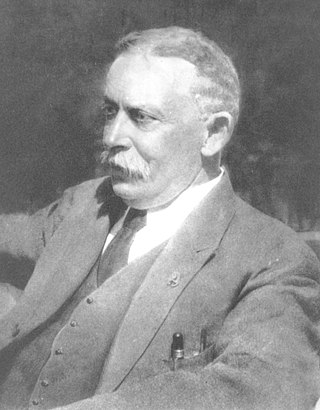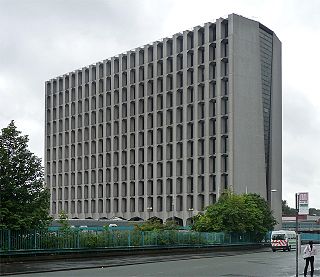
Imperial Chemical Industries (ICI) was a British chemical company. It was, for much of its history, the largest manufacturer in Britain. It was formed by the merger of four leading British chemical companies in 1926. Its headquarters were at Millbank in London. ICI was a constituent of the FT 30 and later the FTSE 100 indices.

Coomassie brilliant blue is the name of two similar triphenylmethane dyes that were developed for use in the textile industry but are now commonly used for staining proteins in analytical biochemistry. Coomassie brilliant blue G-250 differs from Coomassie brilliant blue R-250 by the addition of two methyl groups. The name "Coomassie" is a registered trademark of Imperial Chemical Industries.

Blackley is a suburban area of Manchester, England. Historically in Lancashire, it is approximately 4.5 miles (7.2 km) north of Manchester city centre, on the River Irk.

Heinrich Caro, was a German chemist.

Raphael Meldola FRS was a British chemist and entomologist. He was Professor of Organic Chemistry in the University of London, 1912–15.
The Society of Chemical Industry (SCI) is a learned society set up in 1881 "to further the application of chemistry and related sciences for the public benefit".
Charles Frederick Cross FRS was a British chemist.

Victor Gustav Bloede I, was a chemist and manufacturer of chemicals, president of the Victor G. Bloede Company, and businessman.
British Dyestuffs Corporation Ltd (BDC) was a British company formed in 1919 from the merger of British Dyes Ltd with Levinstein Ltd. The British Government was the company's largest shareholder, and had two directors on the board.
John Donald Rose FRS was a British industrial chemist, who worked for Imperial Chemical Industries from 1935 to 1972. His posts at ICI included director of research and chairman of the paints division. He was also Master of the Worshipful Company of Salters.
John Rex Whinfield CBE was a British chemist. Together with James Tennant Dickson, Whinfield investigated polyesters and produced and patented the first polyester fibre in 1941, which they named Terylene equal to or surpassing nylon in toughness and resilience. He was born in Accrington, but moved out of town before the age of 4.
Professor Bodo Linnhoff is a chemical engineer and academic who developed Pinch Analysis, a methodology for minimising energy usage in the process industries. In its early days, the technique helped companies such as ICI and BASF to design plants that used roughly 30% less energy. As of the 1990s, Pinch Analysis became industrial standard in the oil refining and petrochemical industries. In 2010, Linnhoff founded a finance company, Harvester International, which nurtures innovation and guides smaller companies, such as Inview Technology.
The Clayton Aniline Company Ltd. was a British manufacturer of dyestuffs, founded in 1876 by Charles Dreyfus in Clayton, Manchester.
Francis Arthur Freeth was a British industrial chemist. He spent much of his career at Brunner Mond and its successor Imperial Chemical Industries, as chief chemist, research manager and in a recruiting capacity, with particular knowledge of phase rule chemistry, and developed many processes related to the manufacture of explosives. He made a critical contribution to the British World War I effort by devising new ways to manufacture ammonium nitrate, which was recognised with an honour, and a smaller contribution in World War II for the Special Operations Executive. Freeth created links between Brunner Mond and Dutch chemistry, particularly at the University of Leiden where he met Kammerlingh Onnes and was awarded a doctorate.
Alfred Spinks, was a British chemist and biologist.

Hexagon Tower is a specialist science and technology facility located in Blackley, North Manchester, United Kingdom.
Rudolf Hugo Nietzki was a German chemist who specialized in industrial dyes derived from coal tar. While a professor at the University of Basel in Switzerland he initiated the university's association with to the local chemical industry.
Dr Cecil John Turrell Cronshaw FRSE DSc was a British industrial chemist, Manager of the Manchester Ship Canal and Director of the chemical giant, ICI. He was involved in the evolution of modern industrial dyes.
Levinstein Ltd was an important Manchester based British dye-making company founded by Ivan Levinstein (1845-1916). In 1918 the firm became part of British Dyestuffs Corporation which in turn formed part of Imperial Chemical Industries in 1926. The firm had operations in Salford, Hulton House in Blackley, and during World War I a sequestered German-owned plant in Ellesmere Port. The firm made the successful Blackley blue or Coomassie brilliant blue, a Manchester Brown, a Manchester Yellow dye and during WWI chemicals for military purposes.

A colorant is any substance that changes the spectral transmittance or reflectance of a material. Synthetic colorants are those created in a laboratory or industrial setting. The production and improvement of colorants was a driver of the early synthetic chemical industry, in fact many of today's largest chemical producers started as dye-works in the late 19th or early 20th centuries, including Bayer AG(1863). Synthetics are extremely attractive for industrial and aesthetic purposes as they have they often achieve higher intensity and color fastness than comparable natural pigments and dyes used since ancient times. Market viable large scale production of dyes occurred nearly simultaneously in the early major producing countries Britain (1857), France (1858), Germany (1858), and Switzerland (1859), and expansion of associated chemical industries followed. The mid-nineteenth century through WWII saw an incredible expansion of the variety and scale of manufacture of synthetic colorants. Synthetic colorants quickly became ubiquitous in everyday life, from clothing to food. This stems from the invention of industrial research and development laboratories in the 1870s, and the new awareness of empirical chemical formulas as targets for synthesis by academic chemists. The dye industry became one of the first instances where directed scientific research lead to new products, and the first where this occurred regularly.








